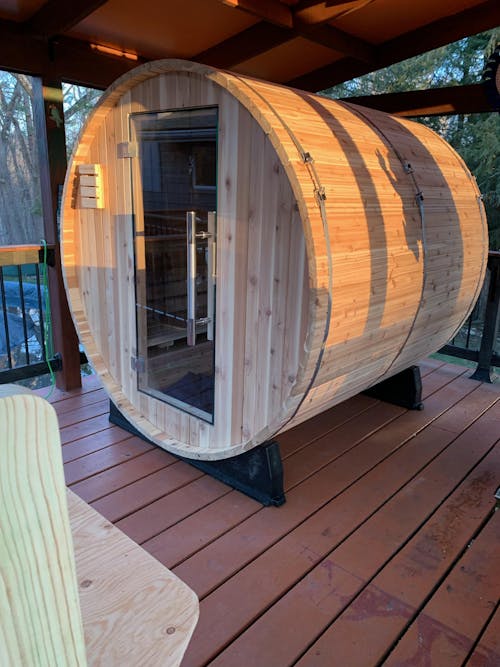Infrared VS Traditional Dry Saunas:
Which One Is Best For You?
When we talk about saunas, the first kind that comes to mind for most people is the traditional dry sauna. Historically these are better known, and have been more widely available. Most high quality hotels and spa centers have had these types of saunas for as long as the establishments have been around, and we can trace the history of the dry sauna back to ancient Rome.
Over the last few decades, a new type of sauna has been invented, and it has been widely tested for its efficacy in comparison to the traditional dry sauna. These infrared saunas function in a different way to their traditional siblings, and research has shown that they cause a higher number of toxins to be released from the body than their older counterparts.
This article will go into the differences and similarities between the two options, and outline the advantages and disadvantages of each. Read on to discover if what you’ve heard about infrared saunas is true or false.
WHAT IS AN INFRARED SAUNA?
An infrared sauna uses infrared heat waves, transmitted by carbon heaters, to warm the sauna. Unlike traditional saunas, the air in the structure is not heated – only the structure itself. Infrared sauna cabins are usually made of natural softwood that is resistant to high temperatures. The specific range of heat waves emitted by the carbon heaters is completely safe for human physiology, and has been carefully selected because they cannot harm the human body.
The purpose of an infrared sauna is healing, and this process is activated by two aspects of the sauna. Firstly, due to the heat it is subjected to, the softwood of the structure begins to release phytoncides – these are organic compounds that exist in many plants, which have antibacterial and antifungal qualities. When we breathe in these phytoncides, our bodies react by increasing the production of a very important white blood cell type that is able to kill off cells in our bodies that are infected with tumors and viruses. They also have a positive effect on the human respiratory system.
Secondly, the sauna warms the body, causing excessive sweating. This is true of all types of saunas and steam baths, and this benefit can be accessed by using any type. Sweating is a very important and essential aspect of human physiology, not just to keep us cool in extreme weather, but also because it causes the release of harmful toxins and substances from the body. These toxins, which usually make their way through the entire blood stream or digestive system before being excreted, can be ejected through the pores of the skin before they can do any more damage.
A few more advantages of infrared saunas over traditional dry saunas are that they are quicker and easier to use – simply plug it in and turn it on – and they emit less heat, which is more comfortable for most people, especially those who do not like the heat and heavy air of the traditional dry sauna.
WHAT ARE THE BENEFITS OF AN INFRARED SAUNA?

There are a number of ways in which infrared saunas will benefit the user. Some of these will apply to traditional dry saunas, as well, but many are specific to the infrared sauna. Below is a list of the benefits you will enjoy when choosing to use an IR sauna.
1. IMPROVED HEATING METHOD
A traditional dry sauna heats the air inside the cabin, which causes the body to heat from the outside, slowly warming up towards the inner organs. These saunas are typically very hot, and can be uncomfortable for some people. An infrared sauna uses the warm rays from the carbon heaters to reach deep within the body, and heat you up from the inside out. They function at much lower temperatures than traditional saunas, which is likely to be more comfortable for most people, but because of their ability to reach the inner organs, they cause a more intense sweat. This ensures that the healing restorative advantages are extended throughout your body.
2. BOOSTED METABOLISM
Sitting in a sauna causes the body to reach higher temperatures, which causes the heart to beat faster, and the metabolism to speed up. The advantages of a faster metabolism include quicker release of toxins and an increased calorie burn. This means that not only will using the sauna help you to detoxify your body, which can help you lose weight when combined with an improved lifestyle, but it will also help you to burn more fat while you relax.
3. IMPROVED BLOOD CIRCULATION
The warmth you are exposed to when relaxing in a sauna causes your blood vessels to expand, and increases blood flow throughout your body. This improves the health of your heart and the elasticity of your arteries, and although your blood pressure will rise in the sauna, it also helps to lower your general blood pressure when done regularly. The added advantage from this is that better circulation ensures better delivery of oxygen to the muscles, improving your ability to exercise, and to recover from muscle stiffness.
4. A NON-PHYSICAL WORKOUT
When you work out, your body goes through a number of interesting changes, all of which are necessary for health and wellbeing. Sitting in an infrared sauna will activate many of these processes, including increased heart rate, improved lymph drainage, expanded blood vessels, and increased lung capacity. Just as a workout helps to protect you from heart disease, so does a session in the sauna!
Please note that you can’t replace all your workouts with sauna sessions. You won’t build strength in the sauna. Use it in conjunction with a good exercise regime for the best results
5. QUICK, EASY, AND AFFORDABLE BEAUTY TREATMENT
For centuries, people have used sweat baths as a way to beautify their skin and purify their bodies. After a sauna, the skin is clean and clear, and natural moisture levels are restored. Sweating brings nutrients to the surface of the skin, and increases the oxygen levels in the dermis, rejuvenating the cells by shedding the old ones and promoting the growth of new ones, making the skin look bright and alive. The production of collagen is enhanced, which increases the elasticity of the skin, and strengthens it, improving complexion, and reversing aging.
6. CENTRAL NERVOUS SYSTEM IMPROVEMENT
Another very interesting advantage of infrared saunas is that they encourage the growth of new brain cells in a process called neurogenesis, due to the increased blood flow and oxygen throughout the body, including the brain.
The infrared rays also increase dopamine production, which is our natural, built-in anti-depressant, and improve the body’s ability to use it. At the same time, the level of cortisol in the brain, the stress hormone, is decreased, raising your mood, as well as your feeling of wellbeing. This makes infrared saunas an excellent treatment for people who suffer from central nervous system disorders, particularly ones associated with mood, like depression, anxiety, and insomnia. Attending repeated sessions in an IR sauna can help people with these problems become more resistant to stress, and cope better with their negative emotions.
7. SPORTS RECOVERY
Due to the increased blood flow throughout the body, essential nutrients and oxygen are able to reach the muscles more quickly, aiding in the reduction of inflammation in the muscles, and facilitating muscle repair and growth. Another advantage is that the increased circulation helps to shift metabolic waste from the muscles, including lactic acid, and move it through your system for elimination. With this in mind, it’s no wonder that both professional and amateur sportspeople alike are avid lovers of the infrared sauna.
8. ACCELERATED DETOXIFICATION
We live in a world in which we are continually exposed to toxins in any number of ways. Even the healthiest of people, like, for example, an organic farmer who uses no chemical pesticides, herbicides, or fertilizers, and eats only his own produce, are exposed to toxins from traffic fumes, smog, and general pollution.
Living in the city, people are exposed to extreme amounts of toxins on a daily basis. To add to this, many of us have habits which add to the toxic load on our bodies, such as smoking, drinking alcohol, or eating foods laden with chemicals, preservatives, and unnatural sugars. Because of our chosen lifestyles, and our unwitting exposure to all manner of toxins outside of our own choices, we need to find ways to facilitate the removal of these toxins from our bodies.
Choosing to spend some time in an infrared sauna is an excellent way to do this. Be aware, however, that spending time in a sauna will not undo any unnecessary damage that you are choosing to do to yourself. For best results, combine your sauna visits with a healthy diet, a good exercise regime, and plenty of sleep.
WHAT IS A TRADITIONAL DRY SAUNA?

Traditional dry saunas can be traced back to ancient times, and are heated by a physical source, such as a wood burning stove or heated stones. While the air humidity in dry saunas is generally quite low, at about 20 to 30%, the air temperature can be anything from around 150 to 195°F, whereas infrared saunas generally operate at between 120 and 150°F. If you are heat sensitive, or have some kind of illness that affects your ability to deal with high temperatures, then a traditional sauna may not be the best solution for you.
Why is it called a dry sauna? Many people think of saunas and assume they are the same as steam rooms. In the case of a traditional dry sauna, it is the same as a steam room, but without the steam. The heating source in the dry sauna is used only to heat the air, but many traditional dry saunas can easily be turned into steam rooms by pouring water onto the source of heat, which increases the humidity in the room, and speeds up detoxification and healing.
You may often see a bucket of water waiting to be used in this way in a dry sauna. Be aware that the higher humidity will prevent your sweat from evaporating, causing you to feel much warmer, so keep your sauna’s humidity lower if you are heat sensitive. Have a look at some of our traditional dry barrel saunas by Almost Heaven, or a wider variety of shapes from Dundalk.
WHAT ARE THE BENEFITS OF A TRADITIONAL DRY SAUNA?

Dry saunas have many of the same benefits as infrared saunas, but as far as we can tell, they don’t have any benefits that aren’t matched or improved in infrared saunas. However, the health benefits of a dry sauna are still incredible, and if you don’t have access to an infrared sauna, or if you prefer the intensity and heat of a dry sauna, there is no reason why you should not continue to use one. Here are the benefits associated with traditional dry saunas.
1. DETOXIFICATION
The higher temperatures of the dry sauna cause pores to open, and facilitate detoxification. The option of making a dry sauna more humid means that the user can intensify the heating of the body, increasing detoxification, and other natural processes.
2. FAT BURNING
As with the infrared sauna, the higher temperature inside the booth causes your heart rate to rise, and blood flow to be improved. However, with the dry sauna utilizing higher temperatures than infrared saunas, the respiratory rate increase is likely to be faster, tricking the body into believing it is exercising. The result of this is that your body will burn more calories than it does at your resting metabolic rate, helping to get rid of excess fat, both around your organs, and under your skin.
3. ELIMINATION OF VIRUSES AND BACTERIA
The high temperatures of saunas stimulate the production of white blood cells in the body, which mimics the body’s reaction to a fever. White blood cells are the healers of the blood, fighting off infections and foreign particles, such as viruses and bacteria. A higher white blood cell count means an improved immune system, and a higher ability to fight off illness.
Some viruses are protected by lipid (fat) layers, and cannot survive if that protective layer is broken down, so spending time in a hot sauna can help to kill off viruses before they ever have a chance to infect you.
4. PAIN REDUCTION
Due to the expansion of the peripheral blood vessels caused by the heat in the sauna, not only will you feel more relaxed and happy, but you will also find relief from pain, especially pain caused by rheumatic diseases, such as rheumatoid arthritis, and inflammatory illnesses, such as bursitis.
It is well known that heat therapy is helpful in managing many different types of pain, and sitting in a warm sauna is an excellent way to treat your body’s various aches and pains, while also getting rid of toxins, inflammation, and possibly even viruses.
5. RELAXATION AND POSITIVE MINDSET
Spending time in a dry sauna should be a relaxing and calming experience. Many people have found that they have better control over their emotions after using a sauna regularly, due to the release of dopamine, and the restriction of cortisol production. Visit your sauna regularly to improve your mood, deal with your anxiety, depression, or insomnia, and improve your overall well being.
SIGN UP. SAVE BIG.
Subscribe to be the first to know about our special monthly sauna sales, sent right to your inbox.
GET THE BEST OF BOTH WORLDS
Reading about the advantages of both types of saunas may not convince you that one or the other is particularly better suited to your individual circumstances. Maybe you love the heat and steam of the traditional dry sauna, but like the idea of some of the added health benefits provided by the infrared sauna. You are not alone in this, and there is a solution. Simply buy one of our excellent hybrid saunas, such as the Almost Heaven Hampton 2 Person Hybrid Sauna.
DISADVANTAGES OF SAUNAS
There are a few disadvantages to using saunas of both kinds, but all of these can be controlled or avoided by you, as the user. The amount of time you spend in the sauna should always be controlled, and you should stick to the times recommended by your sauna operator, or your operator’s manual, in the case of a home sauna. Too much time in the sauna can cause heart overload, dehydration, and low blood pressure. To ensure your safety and health:
-
Consult your doctor or physician before starting a sauna routine, and be sure to keep to the warnings and recommendations set out by them.
-
In the case of illness, please consult your doctor before starting or continuing your sauna routine.
-
If you have a pre-existing condition, like heart problems, heat sensitivity, or a blood disorder, consult your doctor, and if approved, approach your first sauna session with great care.
-
The biggest danger of sauna use is dehydration. Saunas cause you to sweat, which removes essential moisture from your body. Be sure to replace the fluids lost, as quickly as possible.
ADVANTAGES OF INFRARED SAUNAS OVER DRY SAUNAS
To finish up, we would like to list a few more ways in which we feel infrared saunas are better than dry saunas. Our four points are Efficiency, Mobility, Availability, and Frequency.
-
Efficiency: infrared saunas can be set up in just a few minutes, as they only need to be plugged into a regular 110v outlet, and they take about 5 minutes to get going.
-
Mobility: these saunas can be installed anywhere there is an electrical outlet, within certain safety parameters, as long as you have the space. Install it in your lounge, your home office, your workplace, or your holiday home.
-
Availability: infrared saunas are available just about everywhere. If you don’t want to buy one and install it in your house, visit your nearest beauty center, gym, or spa, and you will most likely find one all set up and ready to go.
-
Frequency: unlike a traditional sauna, the lower heat of the infrared sauna means that you can have far more regular sessions with these. Some sources say it is safe to use an infrared sauna every day, but we think every second day is the perfect amount for you to experience all the health benefits of an infrared sauna.
FINAL WORDS
In conclusion, both traditional and infrared saunas have multiple health and wellness benefits, and if you don’t have access to an infrared sauna, you will do far better to use a traditional one than no sauna at all. However, there is plenty of evidence to suggest that infrared saunas are superior, and that the health benefits you will reap from using one will certainly be enhanced.

About the Author
Adam Fromson
Adam Fromson, co-founder of My Sauna World, loves saunas and their transformative health benefits. With years of experience exploring sauna culture and its impact on health and wellness, Adam is passionate about helping others discover the life-changing benefits of saunas for themselves.
Let customers speak for us
from 386 reviews
Good communication, easy delivery, easy set up, easy operation, great value. Recommended!

We ordered the 4 person barrel sauna and love it! We wanted a little extra space for the 2 of us/guests and it’s great. We could definitely fit 4 people in it if we needed. We use it every single day. It took about 10 weeks to get here because they build it specifically for the order. Putting the barrel together was fairly easy with 2 people. The electrical and the heater definitely required an electrician to install as we could have not done it alone.
We ordered the biggest heater (harvia spirit 8kw) and it heats up the sauna in about 15 mins inside our 40-50° garage. Overall this style of sauna is hotter and you sweat a lot faster than in an infrared sauna. I truly 10/10 recommend!
Pic is of us in the middle of building it.

Took me about 6 hours over 2 evenings to assemble almost all by myself. Had a pro run a new circuit from my panel. Very well made and assembly was straightforward. Heater is well sized and reaches operating temperature in under 30 minutes.

Great sauna very easy to assemble

The salt panel was a great addition to our Madison Sauna. It has excellent grain which is accented by the amazing color lights that glow through the panel. Also when you hit the rocks with a splash of water you can feel the heat bounce off the panel. Great addition if you are considering this option.

We can say enough about Sauna World there customer support is great! Our Pinnacle Sauna from Almost Heaven is epic.

The finish and quality is outstanding and it was quick and easy to assemble.

We are thrilled with our mini pod!! It came well shipped and our friend assembled it in 11 hours! Wow! We cannot wait to get healthy and sauna it up!

Beautiful sauna!!! Much easier than I expected to assemble, took a total of 4 hours. Can't wait to get warm by the pool on those cool evenings. Customer service was excellent..

Purchased a 2 person Almost Heaven barrel sauna and were delighted with the product. The order process was quick and easy, the sauna arrived on-time, installation was simple, following the provided instructions, and the sauna is extremely high quality. We’ve used it daily for over 2 weeks and quite frankly I don’t know how we lived without it. If I had it to do over again I wouldn’t change a thing... except maybe purchasing a 4 person model to easier share with friends!

Great Customer Service and a breeze to put together.Excellent shipping and the Sauna is top notch, couldn’t be happier






























